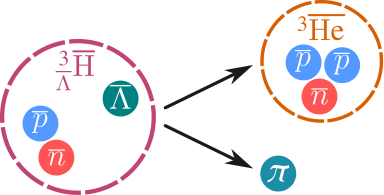The Large Hadron Collider (LHC) has been found to produce the hypernucleus known as hypertriton. If atomic nuclei that sound like electropop bands aren’t enough to get you excited, the production of the antimatter counterpart antihypertriton has also been announced. The quantities produced are quite small for two years of LHC operation, but they offer a rare opportunity to explore particle combinations that may have considerable astronomical significance.
Astronomers have observed the presence of suspected antihelium-3 in space in the form of cosmic rays. Since antimatter particles are rare, the presence of two antiprotons and an antineutron joined together to form an antinucleus is intriguing, and their origins uncertain.
Physicists have proposed this antihelium is a product of the decay of antihypertriton, a type of antihypernucleus. The world’s most powerful particle collider seems a logical place to explore such exotic objects, but the task proved difficult.
Nevertheless, at the European Physical Society Conference on High Energy Physics, held last week in Hamburg, Dr Hendrik Jage of the LHC beauty (LHCb) experiment reported the observation of around 100 hypernuclei in the LHC Run 2 data collected between 2016 and 2018. Most of these were hypertritons, the most familiar hypernucleus. The hypertritons lasted less than a billionth of a second before turning into helium nuclei and pions.
Jage explained that the LHCb is “not designed for helium identification”, so a roundabout way needed to be developed to find the long-lived products, let alone their precursors.
A hypernucleus resembles the conventional nuclei that compose the familiar world, but substitutes one of the protons or neutrons with a hyperon – a type of particle that contains at least one strange quark, but none of three other types of quark. For example, hypertriton is composed of a proton, neutron, and a hyperon. The properties of hyperons frequently allow hypernuclei to be smaller and more tightly bound than the equivalent conventional nucleus.
Jage also reported the production of antihypertriton, which has a similar composition except it is made of antimatter particles, specifically an antiproton, antineutron, and the antimatter equivalent of a hyperon. This similarly breaks down into an antihelium nucleus. The antihypertritons have similarly short lifespans, but particle physicists have got very good at reconstructing the existence of particles they didn’t get to observe directly from their longer-lasting products.

How antihypertriton decays to antihelium-3 and a pion.
Image credit: LHCb Collaboration
Strange quarks are not necessarily any stranger in the conventional sense than all the other members of what is sometimes called the “particle zoo”. However, when physicists noticed that certain particles were created easily in particle collisions, but decayed surprisingly slowly, they came up with a property they called “strangeness” to explain it. Along with regular features of particles, such as a charge a third of that of an electron, strange quarks were found to supply the strangeness to particles that contain them, hyperons included.
Besides investigating how antihypertriton comes to be appearing in space, these hypernuclei are of interest because it is thought hyperons may exist in the inner core of neutron stars, the densest objects in the universe after black holes. The more we know about hyperons, and the hypernuclei they make, the better we can model the workings of neutron star cores.
It has also been proposed that antihelium-3 may be a product of dark matter particle collisions. If so, its presence may be a way to track dark matter and finally find out what it is. However, for this to work we need to know how much antihelium is coming from other sources, which means understanding antihypertriton.
The description of hypernuclei may be almost incomprehensible without a physics degree, but the motivation to find them is not.
The study was presented at the European Physical Society Conference on High Energy Physics 2023. Slides for Jage’s presentation are available here.
[H/T: ScienceAlert]
Source Link: The Large Hadron Collider Is Producing Hypernuclei And Antihypernuclei